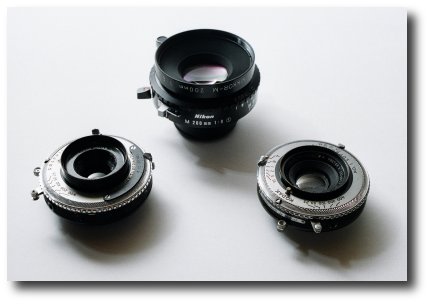
18cm Bausch and Lomb (8x10) f/18 Protar Series V uncoated
200mm Nikkor M f/8
183mm Bausch and Lomb (8x10) f/18 Protar Series V coated
| Home |
| Last update: 06 July, 2005 |
Nikkor 200mm M vs two Bausch and Lomb 8x10 Protar Series V

|
|
From right to left 18cm Bausch and Lomb (8x10) f/18 Protar Series V uncoated 200mm Nikkor M f/8 183mm Bausch and Lomb (8x10) f/18 Protar Series V coated |
My camera kits include everything from 35mm through to ultra large format. In 4x5 work, I like to carry a kit that is very small and light weight. For ultra large format, I recently traded a hugely expensive Schneider 150mm Super Symmar Xl for a brace of usable ULF gear. With the Super Symmar no longer in the stable, I felt the desire to try something "different". I still wanted to occasionally use an ultra-wide lens on the 7x17 Korona. I couldn't justify the cost of the Schneider, but I was hoping to find something old and cheap that might cover the format. With luck, the replacement optic would be lighter and easier to carry than the Super Symmer. Enter the Protar Series V. It is reported to cover a 500mm image circle. So in the interests of scratching the ultra-wide itch, doing it on the extremely cheap, and seeing how they compared against new lenses, I came up with this rather nutty test.
A little perspective -
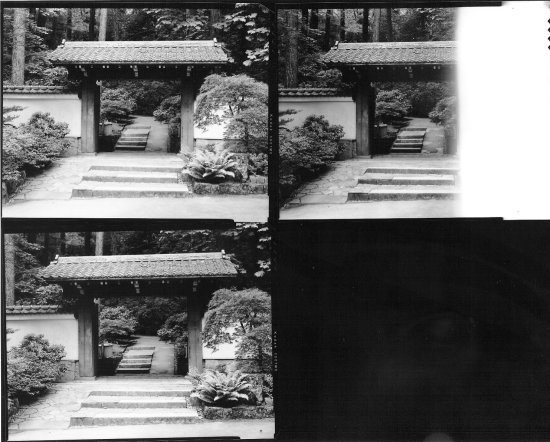
|
|
Unmanipulated contact sheet All exposures on TMax100 film, 1/2sec, f/22
Starting in the lower left corner, proceeding clockwise |
Historically, the Anastigmat Protar was designed in 1890 by Paul Rudolph. The Protar was a simple cemented doublet consisting of high index flint and low-index crown glasses. This was the first photographic lens designed at Carl Zeiss and it provided a flat field. Some used this as a double convertable lens too. The design was licensed to Bausch and Lomb in the US, Krauss in France, Fritsch in Vienna, Koriskta in Italy, and Suter in Switzerland. The claim was that this design was not as good as Zeiss wanted, so they turned their attentions to other optical designs for photographic purposes.
Later, in 1902, Paul Rudolph designed the Tessar. It took the cemented doublet of the Protar and the air spaced lens pair of an "Unar". The resultant 4 element 3 group design was light, small, easy to build and provided good resolution. The design has been very widely copied and included Agfa's Solinar, Ilex's Paragon, Kodak's Commercial Ektar, and Rodenstock's Ysar.
I don't believe there is a modern equivalent to the original Zeiss Protar. But many examples still exist. Surfing eBay usually turns up several Protars of various origins and usually mounted as barrel lenses. The 18cm focal length appears to be popular with 8x10 large format photographers.
On the other hand, a great many Tessar copies are still manufactured today. In large format work Nikon makes the M-series lenses. These tend to live up to the Tessar reputation, are small, light, and are typically quite sharp. Nikon's renditions of the design are claimed to be APO at infinity and come with multi-coatings. This implies that certain improvements have been made to implementations of this design through the years.
The test subjects
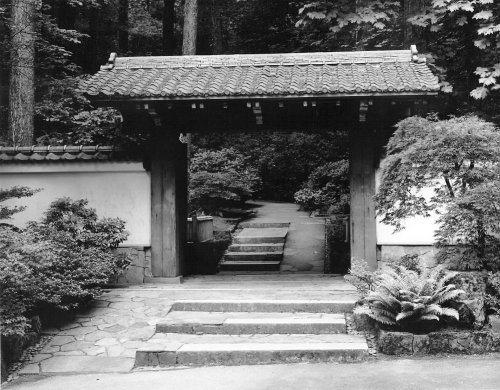
|
|
Lower gate - Japanese Garden 8x10 inch print TMax100 film, 1/2sec, f/22 18cm Bausch and Lomb (8x10) f/18 Protar Series V uncoated |
Next up, a second Bausch and Lomb Protar Series V f/18 lens. The lens is also mounted in a number zero Supermatic shutter. Until these pair landed on my bench, I had never seen so many shutter mounted Protars in one place at the same time. This lens is marked as 183mm (8x10) and has a yellow dot next to a white dot on the front barrel markings. I believe this means the lens is coated. The aperture scale is very clear and crisp. The shutter condition is a little "snappier" than the first Protar's. Both run cleaning at 1 second (which is usually the speed that slows with gum and gunk in old shutters). I suspect the lens weighs less than 200grams.
Last up, a mint condition Nikon 200mm f/8 M-series lens. It is mounted in a number zero Copal shutter. The optics are multi-coated and the overall feel is one of a modern lens. The lens weighs around 200grams, which makes it a joy to carry in the field when I work in 4x5. My example is pleasingly sharp.
The test setup

|
|
Lower gate - Japanese Garden 8x10 inch print TMax100 film, 1/2sec, f/22 183mm Bausch and Lomb (8x10) f/18 Protar Series V coated Shows the effect of pulling a slide open in broad daylight |
Location Location Location
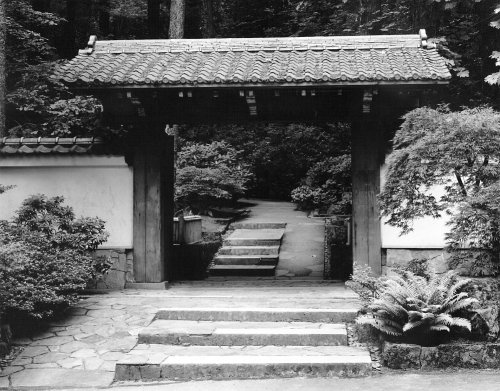
|
|
Lower gate - Japanese Garden 8x10 inch print TMax100 film, 1/2sec, f/22 200mm Nikkor f/8 M |
Working a quickly as a careful approach would allow, I framed the scene using the 200mm Nikkor first. Exposed one sheet of film. Then mounted the 18cm Protar, focused, and exposed the next sheet of film, and so forth. In 10 minutes I exposed three sheets of film using the three different lenses. My friends were talking with me the entire time too. While the conversation was enjoyable, I wasn't entirely sure that I had done everything correctly. It was later that I accidently pulled the darkslide part way out on the 183mm Protar test exposure. Being a little rattled, I failed to notice which lens the damaged film was exposed to. When I re-ran the test I grabbed the wrong lens. So now I have two test exposures from the 18cm uncoated Protar of the same scene. Fortunately, the 183mm Protar image was not completely lost, as is seen here.
One of the biggest concerns I had when working in the field was the slow speed of the Protars. Afterall, f/18 isn't much to work with. So there I was, standing across a road in a brightly lit area trying to focus into dim dark subject matter. Further, the old Anba had its original ground glass. At first I wondered what it might take to fit a Tachihara bright screen to the old wood field camera. But as I worked with the Protars, I realized that they weren't all that difficult to focus. Sure, the Nikkor was much brighter. But if I didn't have a brighter lens to compare against, the old Protars would have been focused with relative ease.
Test results - Beginning with the proof sheet, we see the mistake I made in pulling the darkslide out in broad day light. Note to self: turn the slide retainers to protect the slides from being pulled. When I reached into the bag to pull out the next film holder it caught the slide next to it and pulled it up as I was removing the new holder. Oh well. Live and relearn. This is only the first time in a decade where this happened.
Proof sheet visual inspection
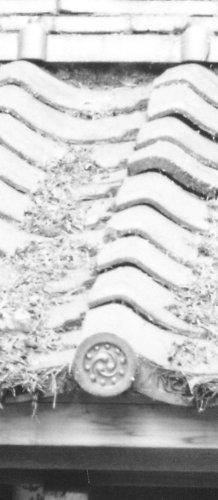
|
|
Lower gate roof tile detail- Japanese Garden TMax100 film, 1/2sec, f/22 18cm Bausch and Lomb Series V Protar f/18 uncoated |
As contact images I can't tell the difference in resolution between any of the lenses. I am impressed by how close the 183mm Protar's highlight control is to the Nikkor's. In fact, I could not tell the difference between them. Rhe 18cm uncoated protar appears to have what I felt to be some slight highlight "blooming". This feeling was further reinforced when I made an image of a bridge later that day.
Using either my 2.25 magnification reading glasses or the 10x loupe to inspect the proof sheets yielded nothing more than my straight visual inspection had. All three lenses showed equal resolution. In particular, the 183mm Protar continued to match the print qualities of the contact printed 200mm Nikkor image.
What this showed me is that for contact print work, the Baush and Lomb Protar Series V lenses were the equal of the Nikkor 200 M. If the Protars adequately cover 7x17, I may not miss the large and value 150mm Super Symmar. Afterall, it would only be contact print work, right?
Visual inspection of 8x10 enlargement images - After carefully inspecting the proof sheets, I turned my attention to 8x10 inch prints that I had made of the lower Japanese garden gate. My thoughts were that if either of the Protars were seriously bad, then perhaps some differences might be revealed as the negatives were enlarged.
Prints from the three lenses yielded images of about equal value in the shadows and highlights. The highlights from the uncoated 18cm Protar were slightly brighter than those in the prints from the 183mm coated Protar and 200mm Nikkor. The uncoated Protar print still showed pleasing details in the highlights.
Regarding print resolution, there were no differences between the three images. I confirmed this first visually, then when using the 2.25x magnification reading glasses, and lastly when viewing the prints with a 10x loupe. This was mildly surprising to me. At a combined 20x magnification (2x print enlargement plus 10x loupe) I was hoping to begin to see some difference between the three lenses. But at this point there were virtually no differences to be seen.
16x20 section enlarged prints
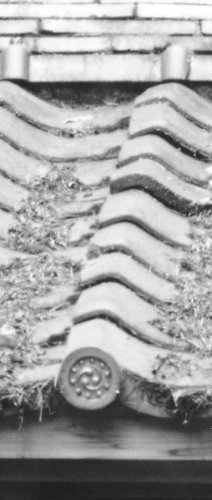
|
|
Lower gate roof tile detail- Japanese Garden Section taken from 16x20inch enlargement TMax100 film, 1/2sec, f/22 183mm Bausch and Lomb Series V Protar f/18 coated |
The 10x loupe confirmed what I thought I saw with the reading glasses. It was then that I realized the last time I took a pair or reading glasses to a gallery to inspect someone's prints was, oh, maybe never. Who carries a 10x loupe with them? We simply don't respond to a print maker's mastership only on the level of resolution that can only be seen with aiding magnifiers. The Protar images enlarged to 16x20 held sufficient detail, contrast, and resolution to yield a very pleasing print.
Enlarger grain focusing negative inspection
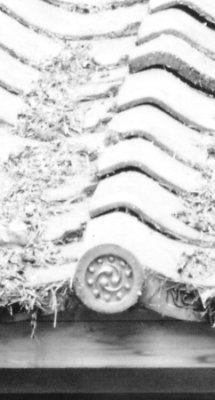
|
|
Lower gate roof tile detail- Japanese Garden Section taken from 16x20inch enlargement TMax100 film, 1/2sec, f/22 200mm Nikkor f/8 M multi-coated |
Conclusions - When I started this test I felt that the Protars would be usable primarily for contact print work. I thought that there would be a big difference in resolution and contrast between the newer Nikkor lens and the c.1940's optics. Afterall, the original Anastigmat/Protar design was superceded by subsequent designs in search of better photographic lenses. In fact, the Dagor design came after the Protar. And the Tessar design came even later than the Dagor.
For this test I limited myself to working in Black and White. Its my chosen medium. So there is no accounting for how the old Protars might behave when shooting color film. From this test I have no idea how color images would compare to the modern multi-coated lens.
Several years ago, Kerry Thalmann and I tested a Series V Protar that he had. It tested at 54 lines per millimeter at f/22 in the center of the field. This is pretty good. Diffraction limits at f/22 are just over 60 l/mm. After inspecting the test negatives at 160x, I think I can see where the Nikkor 200mm M is operating at the f/22 diffraction limits. The images are very sharp and contrasty. The Protars, on the other hand, appear to be not quite as sharp as the Nikkor. These observations are in line with our earlier test results. The thing to remember is that these differences were not revealed until the original test negatives were inspected at 160x magnification. In fact, 16x20 inch prints all showed equal resolution between the three lenses.
The old uncoated example tested here showed the expected lack of highlight control. Over the years I had assumed that uncoated optics that transmit only 70% of the light to film would show visible differences to coated lenses. This indeed seemed to be the case here. If a person wanted to produce prints closer to those from modern lenses, contrast and apparent resolution could be controlled in pleasing ways. One approach that I have thought about was to use Efke 25 or Kodak TMax100 film and to process it in Rodinal at 75:1. The apparent edge sharpness and local contrast would increase. The final results might approach images taken using modern coated optics. In other words, this is a very capable usable lens.
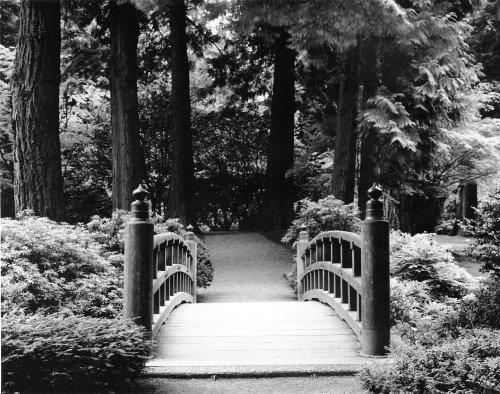
|
|
Moon bridge - Japanese Garden TMax100 film, 1sec, f/32 18cm Bausch and Lomb f/18 Series V Protar uncoated |
If a 4x5 photographer were to find a 200mm Nikkor used for around $400US, there would be no reason not to buy one. The lens is very sharp and contrasty. Alternatively, if a 4x5 working professional need to rely upon their equipment performing flawlessly under a wide variety of circumstances, again, the 200mm Nikkor M f/8 would be the lens of choice.
I am only an overly serious hobbiest and will be taking my 200 Nikkor to South Asia the next time I travel there. The lens is very light (weighs around 200 grams), is mounted in a modern shutter, and is very sharp. It will form the foundation of a very light weight reliable Ikeda Anba 4x5 kit and will be carried along with a 1950's vintage 90mm Angulon f/6.8 and a brand new 150mm Germinar W f/9. The whole 4x5 kit weighs less than a Mamiya 7 camera with two lenses.
For the photo-hobbiest who is keen on owning historic, early design optics, Protar Series V lenses might just fit the need. For photographers looking for inexpensive lenses, there is no need to wonder if its performace is up to "modern" optical standards. The lenses are light, sharp, inexpensive, and a joy to use. For ultra large format photographers working in 8x10, 10x12, and possibly 11x14 and 7x17, Bausch and Lomb (8x10) Series V f/18 Protars offer a nice, light, sharp, simple wide angle option.
My observations led me to consider what has been gained in the last 50 years of optical manufacturing. Lenses are only marginally improved in a practical sense. I can see this in the 160x magnification resolution observations. But I can't see differences between the Protars and modern Nikkor in prints as large as 16x20 inches. This is utterly amazing to me. Perhaps improvements came in the area of shutter reliability? If I had to, the Supermatic shutters could be CLA'd and might easily last another 50 years. So, what has been gained?
From now on I will keep at least one Protar V in my lens kit.
Email if interested in providing comments or feedback: Christopher Perez